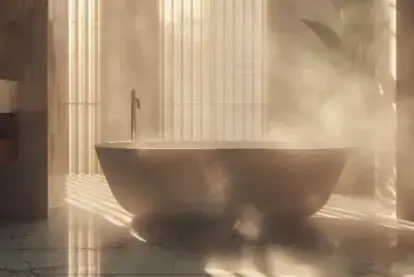How to Mitigate Water Damage in Your Home
Contact COIT for a professional cleaning!
Did you know mold can begin colonizing in as little as 24-48 hours? Mold acts fast, which means you need to act faster.
If you notice signs of water damage in your home or commercial property, it’s critical to take immediate action. Early intervention is key to preserving structural integrity and preventing compounding issues such as mold growth, which is not only damaging to your property but also your health, causing skin and eye irritations along with sinus and respiratory issues. Early intervention lowers the risk of this potential long-lasting water damage and resulting mold growth, which will save you time and money in the long run.
Given many of the materials used to build homes—wood, insulation, and drywall—are porous by nature, water can easily seep into these materials and, without a proper means of drying, can rot and weaken the overall structure. By neglecting to take immediate action, these wet materials can become an ideal environment for mold to grow and thrive. Over time, these mold-ridden areas will need to be removed entirely and fully restored, which can be a tedious and costly procedure.
The sooner you act, the sooner you can remedy the issue and prevent further damage. In this article, we’ll be discussing water damage prevention along with practical steps you can take to mitigate long-lasting damage. We’ll cover immediate actions, drying techniques, and signs it’s time to call in a professional water restoration specialist.
Understanding Water Damage: Causes and Types
Water damage can result from a few sources. Some of the most common include burst pipes, floods, leaks, and even appliance failures. When assessing the issue, it’s important to know the three categories of water damage: clean, gray, and black water, along with their respective risks, to address the situation promptly and properly.
Clean Water
Coming from a sanitary source, such as leaking appliances, rainwater, melting snow, or overflowing sinks and toilets, clean water damage is the least harmful of the three. That said, this form of water damage can still wreak havoc and create mold if left untreated. Luckily, this is the easiest of the three to fix and will likely only require a water extraction procedure and thorough drying.
Gray Water
Gray water is wastewater that stems from a domestic source, such as a sink, toilet overflow, dishwasher, or washing machine, and contains contaminants such as urine. Although less harmful than black water, gray water damage can still cause significant damage to a property, spreading bacteria and contributing to mold growth. While clean water only requires water extraction and thorough drying, gray water damage may require decontamination and sanitization procedures along with water extraction and thorough drying.
Black Water
The most harmful of the three types of water damage, black water is hazardous and highly contaminated, containing fecal matter, dangerous bacteria, harmful pathogens, and toxic materials. In addition to property damage, black water can cause severe health issues such as E. coli, salmonella, and hepatitis A, and should therefore be treated immediately by a professional.

Need professional help? Contact COIT for expert water damage restoration services.
Immediate Steps to Take After Water Damage Occurs
When confronted with water damage, it can feel like a scramble to fix the issue. If you have opted to call in the professionals, there are a few immediate actions you can take before they arrive to ensure the process goes smoothly.
- Ensure the safety of you and your family members. Electric currents flow easily in water. If your home is flooding, do not enter until the electricity is turned off. If possible (to avoid electrocution or electric shock), locate your circuit breaker panel or fuse box and turn off the power before entering. If you notice structural damage or sagging walls, it’s best not to enter the home at all to avoid being caught in a potential collapse.
- If possible, locate and shut off the water source. While outdoor sources such as rain or melting snow are uncontrollable, water coming from an inside source, such as an overflowing toilet or sink, can be turned off at the source or from the home’s shut-off valve. Keep in mind if the water is black (see above) or if you’re unsure, do not come in contact with the water.
- Document the damage. For insurance purposes, you'll want to document the damage in its entirety. Take multiple photos and videos of the affected areas and be sure to capture the extent of the damage. From there, call your insurance company to begin the claims process.
- Move personal items to avoid further damage. If possible, safely remove personal items and important documents from the home so they do not become more damaged. Again, if the home is unsafe, do not enter.
- Remove excess water with a wet dry vacuum or towels. If the water damage is minimal and you’re able to address some of it on your own, apply towels to the soaked area or use a suitable vacuum such as a wet dry vacuum or shop vac to suck up some of the excess water.
Assessing the Extent of Water Damage
After water enters the home, it’s essential to conduct a water damage assessment. Damage can appear in a few key places, including the walls, floors, and ceilings. Below, we’ll discuss common signs and what to look out for when determining the extent of the damage.
Noticeable Cracks
Water can seep into and cause existing foundational cracks to become more obvious after significant water damage occurs. Cracks in a foundation are normal and can be the result of a home settling, however, some cracks are more serious than others and can indicate the need for professional intervention.
Mold growth
Mold after water damage is common because wet environments are ideal breeding grounds. If you notice mold growth in the walls, ceilings, or floors, it needs to be removed entirely. If not completely removed, the mold spores will continue to reproduce and grow. While mold removal is possible to achieve on your own, the Environmental Protection Agency (EPA) recommends professional mold remediation services if the infestation exceeds 10 square feet.
Foul Odors
Musty smells are a key sign of lingering water damage in the home. If you notice a musty smell, this could indicate unaddressed mold or mildew growth in your home’s foundation. If the source of the smell is not immediately noticeable, it may be hiding in the foundation and will need to be addressed by a professional.
Drying Out Your Home: Tips and Tools
Knowing how to dry water damage is one of the most important steps in avoiding long-lasting challenges. Improper drying can lead to mold and costly structural maintenance. By using tools like dehumidifiers, fans, air movers, and moisture meters, you can ensure water dries properly and doesn’t become stagnant. Below, we’ll walk through the process for drying out water damage on different surfaces.
Hardwood Floors
When wet, hardwood floors run the risk of warping, cupping, or mishappen, which can present long-lasting damage to your floors. When drying hardwood floors there are a few key steps:
- Remove any rugs, furniture, and items that may be resting on top of your floors.
- Using a wet dry vacuum or towels, soak up as much of the excess water as possible.
- Because wood is porous, it can harbor and trap mold more easily. For this reason, it’s important to clean your floors after you soak up the water in order to pull any loose dirt or grime out that may have settled into its pores.
- Dry the area thoroughly using fans, air movers, and dehumidifiers if necessary.
- Using a moisture meter, continually monitor moisture levels.
Carpets
After water damage, the space between your carpet padding and the floor remains moist unless dried completely. Because of this, wet carpets are another breeding ground for mold and mildew. Here’s how to ensure your carpets dry thoroughly:
- Remove any rugs, furniture, and items that may be resting on top of your floors.
- Using a wet dry vacuum or towels, soak up as much of the excess water as possible.
- Dry the area thoroughly using fans, air movers, and dehumidifiers if necessary.
- Using a moisture meter, continually monitor moisture levels.
- Steam clean your carpets and clean them with antimicrobial products to remove any stains and prevent mold growth.
Drywall
Drywall is a common material used when building homes and commercial spaces. Given its porous nature, it is also susceptible to mold growth if it comes in contact with water and doesn’t dry properly. Here’s how to dry drywall:
- To increase airflow, remove any wallpaper, baseboards, trimming, and molding around the affected area.
- Dry the area thoroughly using fans, air movers, and dehumidifiers if necessary.
- Using a moisture meter, continually monitor moisture levels.
When to Call a Professional
When water damage is severe, the home or property is deemed “unsafe,” or if there’s significant mold growth, then professional services are recommended.
Water damage poses serious health, safety, and structural damage concerns. While in some cases minimal water damage can be addressed independently, in other cases it is best to let the experts handle it. Again, it’s critical to act fast to avoid further property damage and remain safe. If you’re unsure if your home is safe, don’t risk it—call COIT.
COIT Technicians are available 24/7 and are well-equipped to handle water damage restoration and/or mold remediation services.
For professional water damage services,Contact COIT today!
Preventing Future Water Damage
The good news is there are things you can do both inside and outside the home to be proactive in your efforts to protect your property, possessions, and family from future water damage.
Performing a routine maintenance check of your plumbing system, waterproofing your basement, installing flood vents, and ensuring proper drainage around the home are just a few things you can do to reduce the potential for water damage. In addition to these practical steps, you may also want to consider using smart home devices such as water sensors and automatic shut-off valves, which can be especially helpful if you aren’t home to address the issue immediately.
Final Recap
Time is of the essence when you notice the first signs of water entering the home. To get ahead of mold growth, it’s important to act fast and follow preventative measures to avoid further structural damage. If you’re not sure if the home is safe or if the damage is significant, call the professionals at COIT for all your water damage restoration needs.
For 24/7 rapid response to water damage, Contact COIT today!



